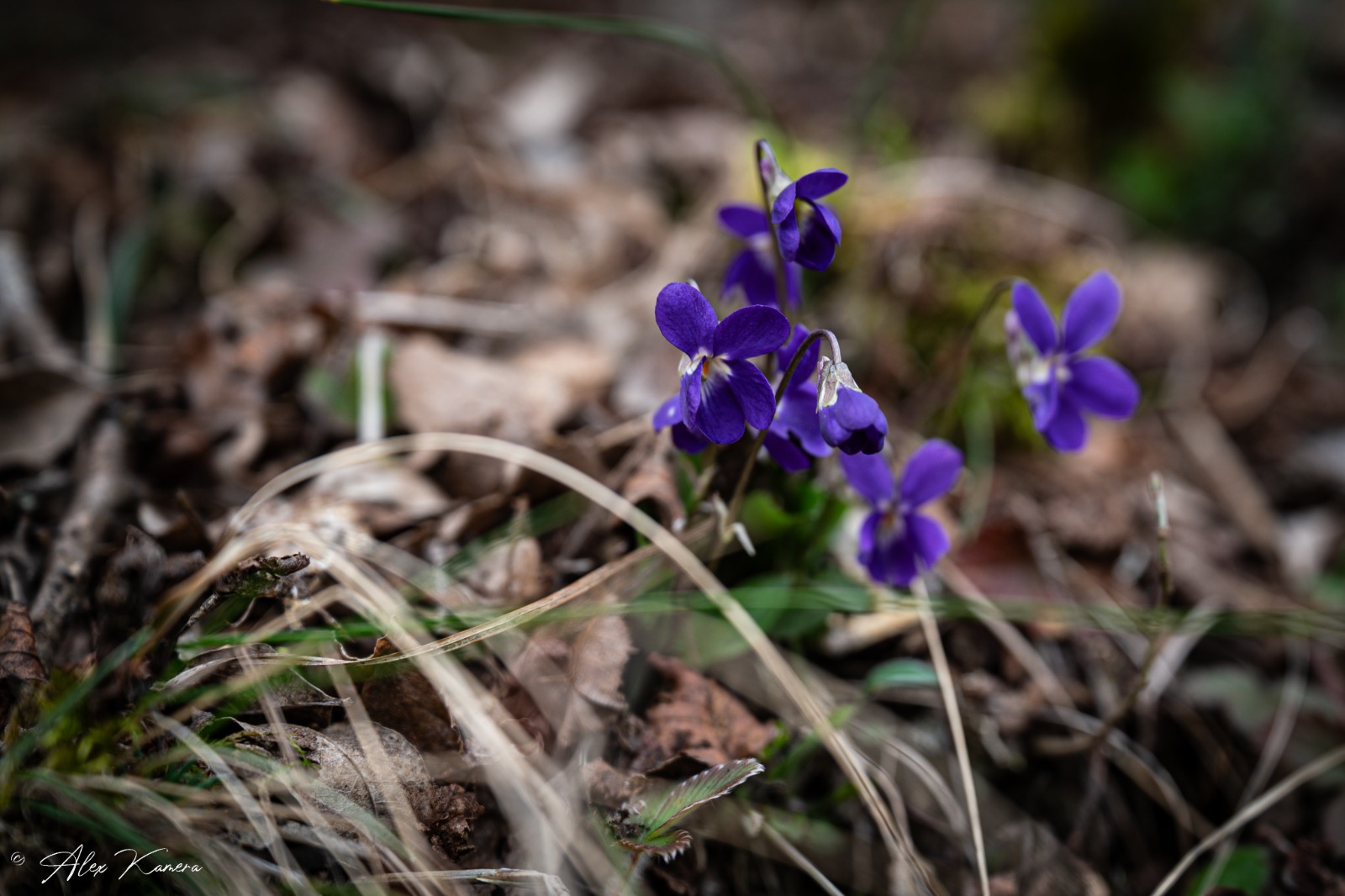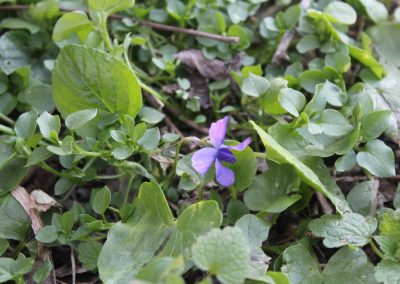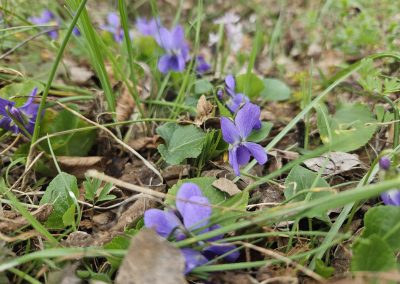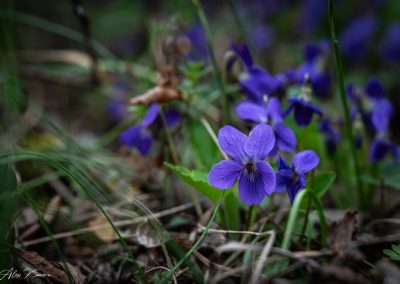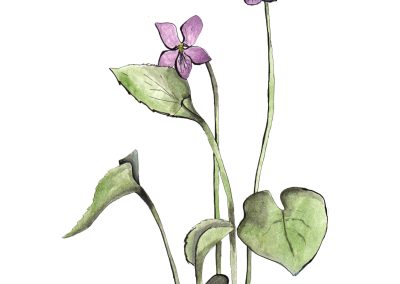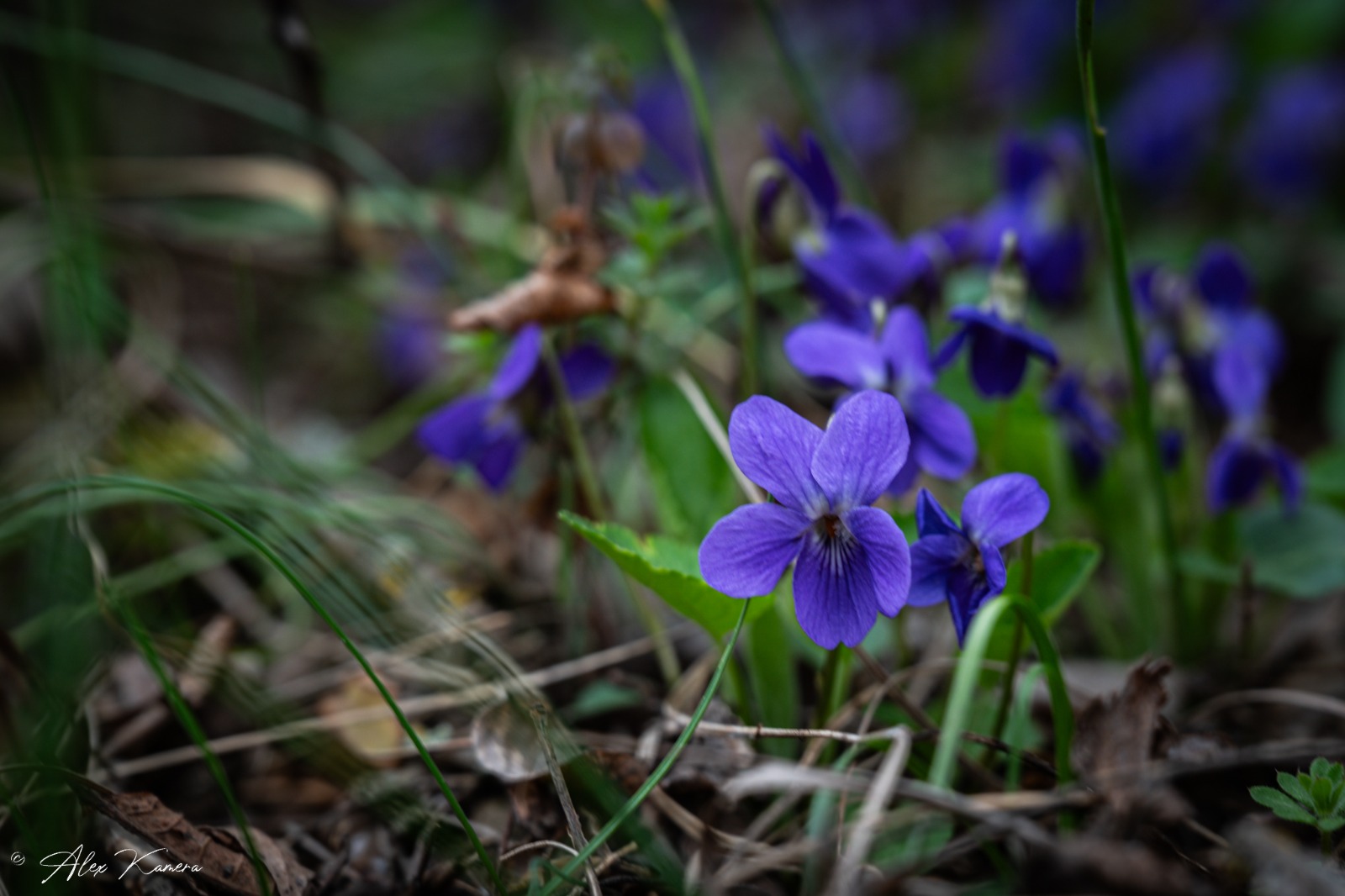Viola Odorata
Scientific description
Phylum: Angiospermatophyta (Magnoliophyta)
Class: Dicotyledonatae (Magnoliatae)
Subclass: Dileniidae
Order: Violales
Family: Violaceae
Common name: Sweet violet
Origin: Northern Europe.
Description:
Perennial herbaceous plant with a thick rhizome from which numerous adventitious roots emerge. Aerial part: rosette of leaves and creeping stems (stolons) with nodes for rooting and new plant formation. Leaves dark green, heart-shaped, toothed, long petioles, small triangular stipules at base. Flowers solitary, fragrant, on long stalks, with 5 unequal sepals and 5 dark violet petals; lower petal with long straight or curved spur. Androecium: 5 stamens; ovary with hook-shaped style. Fruit: globular capsule opening into 3 valves. Seeds small, shiny, with fleshy appendage aiding ant dispersal.
Propagation: Seeds, rhizomes, or stolons.
Ecology: Meadows, clearings, plains, hilly regions; frost-resistant, moderate moisture and soil requirements; wide distribution due to sexual and vegetative reproduction.
Uses: Ornamental; varieties with large, scented flowers from wild species. Petals and leaves used in perfumes. Herbal medicine: aerial and underground parts with emollient and expectorant properties for coughs and bronchitis. Landscaping of yards and gardens.
Threats: Little known as medicinal plant in country; threatened by pasture/shrub replacement with arable land and overgrazing.
Încrengătura: Angiospermatophyta (Magnoliophyta)
Clasa: Dicotyledonatae (Magnoliatae)
Subclasa: Dileniidae
Ordinul: Violales
Familia: Violaceae
Denumire populară: toporași
Originea: nordul Europei.
Descriere:
Plante ierboase perene, cu rizom gros din care pornesc numeroase rădăcini adventive. Partea aeriană: rozetă de frunze și tulpini târâtoare (stoloni) cu noduri pentru înrădăcinare și formarea de noi plante. Frunze verde închis, cordate, cu margine dințată, pețiol lung, stipe mici triunghiulare. Florile solitare, parfumate, lung pețiolate, 5 sepale inegale și 5 petale violet închis, petala inferioară cu pinten lung drept sau îndoit. Androceul: 5 stamine; ovar cu stil în formă de cârlig. Fruct: capsulă globuloasă ce se deschide în 3 valve. Semințe mici, lucioase, cu corpuscul cărnos pentru dispersia de furnici.
Înmulțire: semințe, rizomi sau stoloni.
Ecologie: lunci, poieni, regiuni de câmpie și deluroase; rezistente la ger, cerințe moderate de umiditate și tip sol; răspândire largă datorită reproducției sexuale și vegetative.
Utilizare: Decorative; varietăți cu flori mari, parfumate. Petale și frunze în parfumuri. Fitoterapie: părți aeriene și subterane cu proprietăți emoliente și expectorante, pentru tuse și bronșite. Amenajarea curților și grădinilor.
Pericol: Puțin cunoscut ca plantă medicinală; amenințată de transformarea pajiștilor și tufărișurilor în teren arabil și de pășunat.
Γένος: Αγγειόσπερμα (Magnoliophyta)
Κλάση: Δικοτυλήδονα (Magnoliatae)
Υποκατηγορία: Dileniidae
Τάξη: Violales
Οικογένεια: Violaceae
Κοινή ονομασία: Μοσχοβιολέτα
Προέλευση: Βόρεια Ευρώπη
Περιγραφή:
Πολυετή ποώδη φυτά με παχύ ρίζωμα και πολυάριθμες επιφανειακές ρίζες. Εναέριο μέρος: ρόδακα φύλλων και έρποντες βλαστοί (στόλωνες) με γόνατα για ριζοβολία και νέα φυτά. Φύλλα σκούρα πράσινα, καρδιοειδή, οδοντωτά, με μακριούς μίσχους, μικρές τριγωνικές παραφυλλίδες στη βάση. Άνθη μονήρη, ευωδιαστά, μακριά ποδίσκους, 5 άνισα σέπαλα, 5 άνισα σκούρα βιολετί πέταλα, κάτω πέταλο με μακρύ σπιρούνι. Άνδρειο: 5 στήμονες, ωοθήκη με αγκιστροειδές στίγμα. Καρπός: σφαιρική κάψα ανοίγει σε 3 βαλβίδες. Σπόροι μικροί, γυαλιστεροί, με σαρκώδες προσάρτημα για διάδοση από μυρμήγκια.
Πολλαπλασιασμός: σπόροι, ριζώματα ή στόλωνες.
Οικολογία: λιβάδια, ξέφωτα, πεδινές και ημιορεινές περιοχές; ανθεκτικά στον παγετό, μέτριες απαιτήσεις σε υγρασία και τύπο εδάφους; μεγάλη ικανότητα σε σεξουαλική και αγενή αναπαραγωγή.
Χρήσεις: Καλλωπιστικό φυτό, ποικιλίες με μεγάλα, ευωδιαστά άνθη. Πέταλα και φύλλα σε αρώματα. Βοτανοθεραπεία: υπέργεια και υπόγεια μέρη με μαλακτικές και αποχρεμπτικές ιδιότητες. Χρήση σε κήπους και αυλές.
Απειλές: Λίγο γνωστό φαρμακευτικό φυτό, απειλείται από μετατροπή λιβαδιών και θαμνώνων σε γεωργική γη και υπερβόσκηση.
Phylum : Angiospermatophyta (Magnoliophyta)
Classe : Dicotyledonatae (Magnoliatae)
Sous-classe : Dileniidae
Ordre : Violales
Famille : Violaceae
Nom commun : Violette odorante
Origine : Europe du Nord.
Description :
Plantes herbacées pérennes avec rhizome épais d’où émergent de nombreuses racines adventives. Partie aérienne : rosette de feuilles et tiges rampantes (stolons) avec nœuds pour enracinement et nouvelles plantes. Feuilles vert foncé, cordées, dentées, pétioles longs, petites stipules triangulaires à la base. Fleurs solitaires, parfumées, sur longues tiges, 5 sépales inégaux, 5 pétales violets foncés, le pétale inférieur avec un long éperon droit ou incurvé. Androcée : 5 étamines ; ovaire avec style en crochet. Fruit : capsule globulaire s’ouvrant en 3 valves. Graines petites, brillantes, avec appendice charnu pour dispersion par fourmis.
Propagation : graines, rhizomes ou stolons.
Écologie : Prairies, clairières, plaines et régions vallonnées ; résistance au gel, besoins modérés en humidité et sol ; large distribution grâce à reproduction sexuée et végétative.
Utilisations : Ornementales, variétés à grandes fleurs parfumées. Pétales et feuilles pour parfumerie. Phytothérapie : parties aériennes et souterraines, propriétés émollientes et expectorantes pour toux et bronchite. Aménagement de jardins et cours.
Menaces : Peu connue comme plante médicinale ; menacée par conversion des pâturages et arbustes en terres arables et surpâturage.
Creative writing inspired by Viola Odorata
Written by Andreea-Mihaela Tote
Viola odorata
In a dark forest, where light timidly filtered through the branches of ancient trees, there lived a young nymph named Io. Zeus, the god of the sky, loved Io, but to protect her from the wrath of his wife, Hera, he transformed her into a white heifer. Io wandered through the forest, seeking refuge. One day, weeping over her fate, her tears fell to the ground, and from them sprouted delicate and fragrant flowers–violets. Thus, the flower became a symbol of love and sorrow, carrying the memory of an impossible love.
In another legend, violets appeared where the blood of the hero Attis fell upon the earth. Attis, beloved by the goddess Cybele, died during a hunting expedition, and from his spilled blood violets grew, symbolizing pain and sacrifice. This story was taken up and adapted in Greek and Roman mythology, where violets were associated with the goddess Venus and the tragic love between her and Adonis.
In the Middle Ages, violets were considered symbols of humility and virginity. They were used to decorate the graves of saints and maidens, being associated with purity and sacrifice. Also, in Christian tradition, violets were often planted on the graves of loved ones, as a sign of eternal love and respect.
Today, violets (Viola odorata) continue to be appreciated for their beauty and fragrance. They are used in perfumery, in traditional medicine, and as a symbol of love and memory. Thus, the delicate violet flower remains a silent witness to stories of love and sacrifice from the past.


